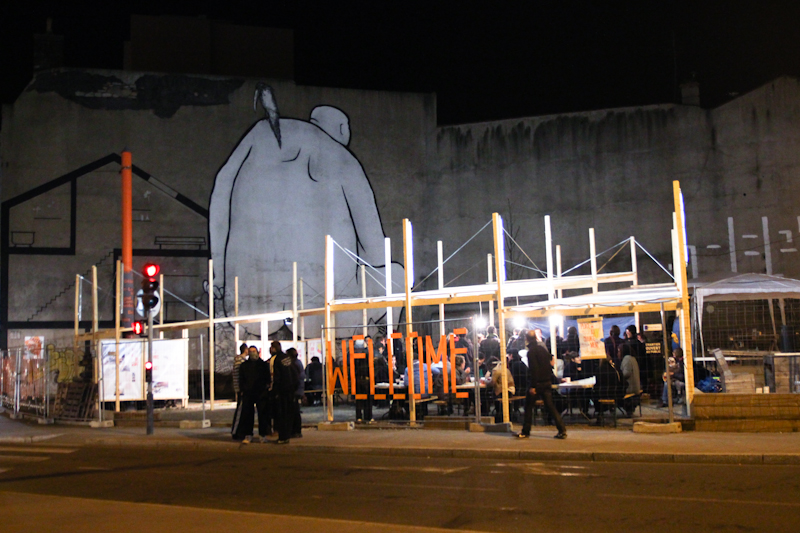Milan-Marseille, 12.03.2020
Skype call

COLLECTIF ETC: ...LIKE PLANTS GROW
FRANCESCA GOTTI: We tend to consider that practices like yours are flexible in collaborating with other professionals. But your key tool is design: what is the role of the object you create in the process your projects?
COLLECTIF ETC: One of the main things we are doing is designing with building. We design our projects but we build them as well, and this is an essential aspect in giving autonomy to people. So, we don’t only use design, we often try to use storytelling to create a narrative around the spaces we work on, so that inhabitants can see them in a different way. We can use various methods, not only construction, but also photos, videos, writing, painting and screen printing. We want to create something that can make different situations happen once we finish the project. We want to begin with small projects that people can take over: this is very different from the usual processes of public space production, which are expensive, take years to start and are exclusively accessible for those managing. We are more flexible and we can make things happen immediately, and this applies to public space and architecture in general: people don’t need to wait and don’t need big investments to make it happen, we start the project by making it.
FG: It is more about the process rather than the project, about scanning all the resources available, material and human, and making the best out of them. And finally, creating a good relationship with the people involved.
CE: And it is also a matter of time: it is better for us to have more time to work on a community and an area and distribute funding over time. We want to make living space in the same way that plants grow. In Les Gourmandilles, for example, a local association in a rural area near Marseille wanted to create a building as their venue. We have been working with them for the last 5 years, and we started by creating a small coffee shop, which is community-run. From this first intervention they were able to grow: with the coffee being in a small space, they could manage it well and engage more people progressively. Having this small tool, they started to create a dynamic and expand, and now they are working in other villages: each time we help to create the tools they need: gardens, other coffee shops, shelters… We like to refer to landscape architects, who work with plants to create an environment, plants that need water and sun to grow: public spaces and architectures need the same care as plants every day.
FG: It is not about delivering a final package to someone but growing together with inhabitants. In the same way as you plant a seed to grow something, what is usually the starting point of your work?
CE: There might be three ways to start a project and “plant the seed.” Sometimes. we try to plant the seed ourselves, but this can be very tricky. A second situation can be when inhabitants start an initiative autonomously, like gathering as an association or starting activities in a public place or in a building; for us it’s not about the typology of the space but about its nature as a common entity. The third case would be when the public authorities and institutions plant the seed. What we have learned is that the most interesting situation is the second one: when we join an initiative started by a local community, especially in small contexts like rural areas. At the beginning of our practice, we thought that starting a project ourselves could be enough to produce a dynamic; after 10 years, we think that we can’t and we don’t want to take on all the challenges at the same time. Also, as Collectif Etc we have a nomadic way of living, and these projects need stable and permanent engagement: if we start a project and nobody is deeply interested in continuing it when we leave, and we didn’t succeed in raising a local community, then the project will fail. This is what happened in Épopée Puget, where we were the initiators and we started working with the municipality through meetings and workshops, involving many people, especially young ones. But we reached a point when the municipality was supposed to take over the process and in the end nobody took care of it, they abandoned it, they never maintained it: this project failed because nobody continued the dynamic we had started.
FG: Municipality is obviously in charge of safety and infrastructures. But it is necessary that people feel entitled and responsible for taking care of spaces.
CE: Our desire in these projects is for people to organise themselves. In big cities, municipalities are even harder to reach, they are disconnected from the everydayness of reality. People have to become proud and strong; they must identify with the public spaces and be autonomous, and as architects we are responsible for giving them the tools to achieve this autonomy.
[...]
Extract from the interview "A talk with Collectif Etc: ... as plants grow" Full text available in the book "The Design of Tactics: Critical Practices for Public Space Re-Activation," forthcoming.
AUTONOMY
Cafe sur Place, Bordeaux (FR, 2012)
From 2 to 14 April 2012, the Collectif Etc was invited by the residents’ association of Yakafaucon to carry out an open site on Place Dormoy, in Bordeaux. The objectives of the intervention were numerous here. First, highlighting the future associative café and its location on the square. Then, proposing a layout of the square synthesising the proposals resulting from the consultation without freezing or restricting other possible uses, existing or to come. It remained in place for six months, as provided for in the temporary occupancy agreement signed with the city.